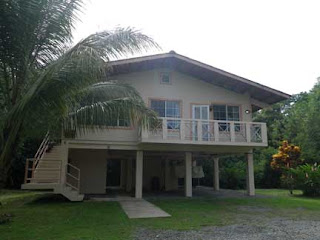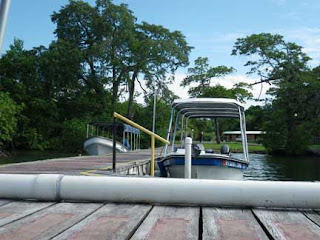On Sunday I looked out the back window of our house and saw something brown and furry hanging from a tree! I thought it might be a howler monkey so I grabbed my camera. Just then it turned around I saw the smiling face of a three-toed tree sloth! I took many pictures, but despite its name it moves pretty fast. Here are a couple of the best. I also made a video of it moving gracefully through the branches.
Panama Mangroves
During a 2-week scientific field trip to Bocas del Toro, Panama (Caribbean side), Dr. Marguerite Toscano will describe the mangrove environment, the species present, ecological importance and some of the scientific work she and several other scientists will be doing.
Panama Mangroves
Welcome! I (Dr. Maggie Toscano, Geologist) am about to embark on a field excursion to the Bocas del Toro province of Panama with several scientists interested in the mangrove environment and how it functions.
We will be investigating how mangroves grow and develop in the presence or absence of certain key nutrients, how mangrove crabs and other species use the mangrove trees, roots, and the peat they form as their habitat, and how mangroves respond to sea-level and climate changes over long periods of time (thousands of years).
We will be staying at the Smithsonian Tropical Research Institute in Bocas del Toro. Stay tuned for news, science and photos over the next two weeks!
We will be investigating how mangroves grow and develop in the presence or absence of certain key nutrients, how mangrove crabs and other species use the mangrove trees, roots, and the peat they form as their habitat, and how mangroves respond to sea-level and climate changes over long periods of time (thousands of years).
We will be staying at the Smithsonian Tropical Research Institute in Bocas del Toro. Stay tuned for news, science and photos over the next two weeks!
Monday, November 15, 2010
Sunday, November 14, 2010
Processing samples
Tiny crabs seived from mangrove leaf litter.
The dead wood is stripped of bark, then broken open to search for insects that bore into the wood and use it to lay eggs or to live out their larval stages. We are finding centipedes, solitary green bees, various larvae and black ants. Those are the most difficult to sample. They try to escape from the sample tube every time I open it to add another!
Why do we do this? The trees we are sampling are part of an experiment to see which nutrients are available in the natural environment and which are less common. The trees are in three groups - Control (natural, no fertilizer), Nitrogen, and Phosphorus. N and P both occur in the marine environment but not in equal amounts; the lesser of the two may be the “limiting nutrient,” meaning that tree growth is limited by the availability of that nutrient. Adding more of a nutrient is a way to see if it makes a difference in tree growth. Sampling the critters allows us to measure how nutrient enrichment may be trasferred through the mangrove ecosystem (at least of the treated trees) and how that affects the productivity and diversity of other organisms that utilize everything from submerged roots to high branches.
Snorkeling in the Mangrove Roots and Seagrass Beds
The Author, up a tree in the mangrove fringe.
Sampling dead twigs from the higher branches.
After a long hot day climbing through the “mangrove jungle gym” we had a chance to jump into the lagoon and see the underwater communities that live on the seagrass bottom and on the mangrove roots. Seagrass beds in the tropics are populated by an amazing combination of plant and animal families, from turtle grass and numerous types of green and red (both hard and soft) algae, to corals, fan worms, sea cucumbers, sponges, jellyfish and echinoderms (urchins and sea stars). One photo may include so many organisms that you won’t be able to find them all in one viewing. Look at the photos in this post to see how many life forms you can differentiate. Identification requires good field guides.
Cushion sea star among algae, coral, turtlegrass, worms and sponges.
Most fascinating are the prop roots of the Red Mangrove (Rhizophora mangle) which extend down into the seagrass beds. These roots contain a specific ecosystem that includes mangrove oysters, many colorful stinging sponges, corals, anemones, algae, tunicates and small encrusting organisms.
Rhizophora prop roots hanging into seagrass beds, covered with attached marine life, particularly sponges and oysters.
Sponge covered root with large fan worm.
Mangrove oysters.
Fire coral (Millepora sp.) encrusting a prop root.
Fire sponge - pretty, but don't touch it. It earns its name in burning pain from stinging cells.
The same goes for the fire coral.
Mangrove prop roots are an essential development habitat for many reef fishes. The juvenile fish live in the protective roots to avoid predation until they are large enough to migrate to the reef as adults. In some areas (e.g. parts of Belize) where mangroves have been destroyed to clear areas for shrimp farming or resort construction, economically and culturally important fish populations have gone extinct locally.
Mangroves are very important as coastal protection from erosion during major storms, as a filter for excessive surface runoff (to trap contaminants before the runoff enters the sea) and as a vast ecosystem for diverse and numerous large and cryptic life forms. Preservation of mangroves is more important to the economies of their home countries than selling and cutting them for commercial purposes.
Thursday, November 11, 2010
More STRI photos
STRI Lab looking down the ramp towards the water.
Baby Croc in the lab pond (about 3-4 ft long).
Our house, Casa Cofrin.
Ginger flowers.
STRI Dock
Lab Building.
Thursday - a day to rest, work on samples and blogs
Thursday Nov. 11 – Happy Veterans Day. We are working at the lab today to process samples and take a rest from the field and give our muscles and scratches, bruises and insect bites a chance to recover. There have not been many bugs, thank goodness, but insect repellent is still a must. So is sunscreen – you can feel charred and crispy despite conscientious re-application. It is nice to write this in an air-conditioned lab.
Today we are sorting through mangrove litter (leaves, wood and other muck scooped from the base of the trees) for small critters (crabs, amphipods, isopods). While doing this I am learning to identify peat components that I might find deeper in core samples. Back to work!
Small crabs found in the mangrove leaf litter.
Here are some photos of the STRI lab at Bocas del Toro. You can also look at the STRI website mentioned in Tuesday's post.
The main lab building.
Wednesday at Solarte
Weds. Nov. 10 – Today we went to the Solarte site, which was a dense dwarf mangrove that was particularly difficult to navigate (see photos). Imagine walking in dark, knee-deep water tripping over unseen roots and seemingly impenetrable trees while carrying large buckets full of gear, and later, when you are hot and tired, buckets filled with heavy samples. While it looks worse than it is, it takes a lot of time and patience and a huge sense of humor to do field work here, because a few trips in and out of the mangrove carrying these buckets can’t be done gracefully or in a hurry. You just keep clearing the trees gently out of your way while trying not to damage them as you pass, and trying not to trip or break your ankle when stepping into dark water where you can’t see the bottom. While it may seem we are in a tropical paradise (true), we are still working hard in the heat and sun. I’m just setting the record straight, not looking for sympathy, and I know it is cold back home! This is incredibly interesting and challenging and I am very pleased to have the chance to experience this and learn so many things. I’m a geologist working with biologists, and there is no better way for me to gain firsthand knowledge of these ecosystems.
The entry fringe zone at Solarte.
The interior, dense dwarf Rhizophora forest at Solarte.
Grad student Caroline working with her coring device.
Rhizophora prop roots hanging into the lagoon outside the forest. The roots are an ecosystem all their own. See the mangrove oysters and red fire sponge, among other species, that live only on those roots.
We had a nice dinner out in Bocas. We sat right at the water’s edge in an open-air restaurant where we ate coconut rice, fish with Creole sauce and veggies. While we were eating a huge barracuda jumped out of the water and stayed where we could see it swimming near the dock.
Cristobal Photos
Waterway at Cristobal.
Inside the Cristobal site looking at the mountains on the mainland.
Starting in!
A view of the dwarf Rhizophora environment.
Leaf scars that can be used to count the age of the trees.
This is what it looks like inside the mangrove.
Subscribe to:
Comments (Atom)



































